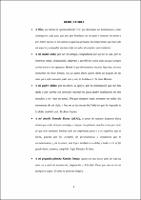Mostrar el registro sencillo del ítem
Cambios de la discrepancia maxilomandibular con los estadios de maduración no sea por el método de vertebras cervicales
| dc.contributor.advisor | Carruitero Honores, Marcos Jimmy | |
| dc.contributor.author | Ponte Bueza, Jeresbith Dayan | |
| dc.creator | Ponte Bueza, Jeresbith Dayan | |
| dc.date.accessioned | 2016-10-28T17:15:26Z | |
| dc.date.available | 2016-10-28T17:15:26Z | |
| dc.date.issued | 2016 | |
| dc.identifier.uri | https://hdl.handle.net/20.500.12759/2028 | |
| dc.description.abstract | El objetivo de la presente investigación fue comparar la discrepancia maxilomandibular de los estadios de maduración ósea por el método de vértebras cervicales. La muestra estuvo constituida por 108 radiografías cefalométricas. La determinación de los valores lineales (longitud efectiva maxilar y longitud efectiva mandibular) se realizó mediante ordenador empleando el programa DimaxisPro versión 10. Los cambios se evaluaron empleando las pruebas estadísticas Kruskal Wallis y U-Mann Whitney, su relación con los estadios de maduración mediante el coeficiente de correlación de Spearman. Se consideró 5% de nivel de significancia. Los resultados mostraron diferencias estadísticamente significativas entre las discrepancias máxilomandibulares en los estadios de maduración ósea por el método de vértebras cervicales, presentándose mayor discrepancia en el estadio VI (p<0.05). Se encontró correlación estadísticamente significativa entre los estadios de maduración con la longitud efectiva mandibular y la discrepancia maxilomandibular, obteniéndose coeficientes de correlación de 0.401 y de 0.369 respectivamente (p<0.05). No se encontraron diferencias estadísticamente significativas entre la discrepancia maxilomandibular según el sexo. En conclusión, se encontraron cambios de las discrepancias máxilomandibulares con los estadios de maduración ósea el método de vértebras cervicales, presentándose mayor discrepancia en el estadio VI. | es_PE |
| dc.description.abstract | The aim of this investigation was to compare the discrepancy maxillomandibular stages of bone maturation by the method of cervical vertebrae. The sample was constituted by 108 cephalometric radiographs. The determination of linear values (effective length maxillary and mandibular effective length) was made using the DimaxisPro program version 10. The changes were evaluated using statistical tests Kruskal Wallis and U-Mann Whitney andthecorrelationby using Spearman's rank correlation coefficient. 5% level of significance was considered. The results showed statistically significant differences between maxilomandibular discrepancies in stages of bone maturation by the method of cervical vertebrae, showingthe greatest discrepancy in the VI stage (p<0.05). Statistically significant correlation between stages with the effective length ofmandibular and discrepancy was found, yielding correlation coefficients of 0.401 and 0.369 respectively (p< 0.05). No statistically significant differences between the maxilomandibular discrepancies were found by sex. In conclusion, changes of maxilomandibular discrepancies in the stages of bone maturation by the cervical vertebrae method were found, showing the highest discrepancy in the VI stage. | en_US |
| dc.description.uri | Tesis | es_PE |
| dc.format | application/pdf | es_PE |
| dc.language.iso | spa | es_PE |
| dc.publisher | Universidad Privada Antenor Orrego | es_PE |
| dc.relation.ispartofseries | T_ESTO_383 | |
| dc.rights | info:eu-repo/semantics/openAccess | es_PE |
| dc.rights.uri | https://creativecommons.org/licenses/by/4.0/ | es_PE |
| dc.source | Universidad Privada Antenor Orrego | es_PE |
| dc.source | Repositorio Institucional - UPAO | es_PE |
| dc.subject | Discrepancia maxilomandibular | es_PE |
| dc.subject | Longitud efectiva maxilar | es_PE |
| dc.title | Cambios de la discrepancia maxilomandibular con los estadios de maduración no sea por el método de vertebras cervicales | es_PE |
| dc.type | info:eu-repo/semantics/bachelorThesis | es_PE |
| thesis.degree.level | Título Profesional | es_PE |
| thesis.degree.grantor | Universidad Privada Antenor Orrego. Facultad de Medicina Humana | es_PE |
| thesis.degree.name | Cirujano Dentista | es_PE |
| thesis.degree.discipline | Estomatología | es_PE |
| dc.subject.ocde | https://purl.org/pe-repo/ocde/ford#3.02.14 | es_PE |
| renati.type | https://purl.org/pe-repo/renati/type#tesis | es_PE |
| renati.level | https://purl.org/pe-repo/renati/level#tituloProfesional | es_PE |
| renati.discipline | 911016 | es_PE |
| dc.publisher.country | PE | es_PE |
Ficheros en el ítem
Este ítem aparece en la(s) siguiente(s) colección(es)
-
Estomatología [653]


